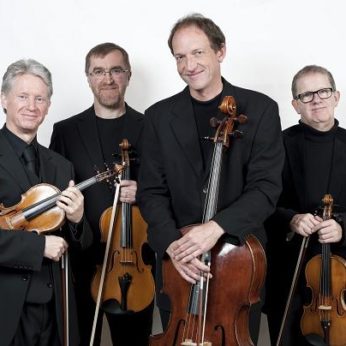Composer: Ludwig van Beethoven (b. 1770 - d. 1827)
Performance date: 28/06/2014
Venue: Bantry Library
Composition Year: 1826
Duration: 00:37:50
Recording Engineer: Richard McCullough, RTE
Instrumentation: 2vn, va, vc
Instrumentation Category:String Quartet
Artists:
Vanbrugh Quartet (Gregory Ellis, Keith Pascoe [violins] Simon Aspell [viola] Christopher Marwood [cello]) -
[quartet]

It is often assumed that, after the Ninth
Symphony, Beethoven retired into a private world to write string quartets for
his own satisfaction. Nothing could be further from the truth for Beethoven was
being besieged by publishers offering high prices for new quartets. What is
more, these offers were over half the price that he got for the Ninth Symphony
and you do not have to be a composer to know the difference in the amount of
work involved. This public demand for quartets marks a significant social
change that took place in Beethoven’s lifetime. In the 1790s most of his
chamber music was written for individual patrons with publication being of
secondary importance; but by the 1820s publication had become his main source
of income. Only in
where society was much slower to change, was an individual such as Prince
Galitzin still prepared to pay for a commission. So as publishers were still
queuing up after the completion of the three Galitzin Quartets, Beethoven moved
straight from the Grosse Fuge to the
opening fugue of Op.131.
There is a perfect symmetry about Beethoven
answering the spectacular questions posed by the Grosse Fuge with a second fugue of Bach-like purity. This time
Beethoven changed his approach and he repeatedly sketched this quartet’s
overall shape and tonal structure in total contrast to the unplanned way in
which movements were tacked onto each other in Op.130. The majestic Adagio presentation of his other-worldly theme
proceeds with successive entries until gently attaining its full sonority. At
the centre of this progression is a still small voice that is the answer to all
the storms and earthquakes in Beethoven’s life.
The second movement seems to sneak out of
the shadow of the opening fugue so subtly that the listener can find himself in
the Allegro without realising how he
got there. However it quickly generates some rhythmic ardour, which twice
dramatically decelerates. The third hesitation introduces the brief coda, which
in turn leads to the eleven bars of the recitative-like third movement, a mock
operatic interlude ending with a coloratura flourish from the first violin
leading to the aria of the Andante.
This crucial movement begins dolce in the sudden brightness of A
major supported by dynamic pizzicati in
the bass. This is the geometric centre of the work and the six variations are
each as different in spirit, rhythm and tempo as are the seven movements
themselves. The apotheosis comes in the final variation adorned with trills
inevitably reminding us of the Arioso of
the last piano sonata, though the ending is curiously hesitant and disembodied.
The cello now seizes on a fragment of a
theme that sets in process the massive Scherzo. This theme takes off at high speed, suddenly breaks off with
descending echoes, slows up for a few bars and experiences some other hold ups,
and then without transition or break in tempo or key, the initial theme
engenders a new one, related but calmer.
The alternation of these two grand episodes provides the frame for the whole
edifice, bubbling with irrepressible vitality until the final sul ponticello reprise.
The Adagio provides a brief moment of contemplative calm before the surge of
the final Allegro. This huge movement
seems to return to before where we began, to the fighting spirit and
iconoclastic power of the Grosse Fuge.
Richard Wagner describes this movement as the
most anguished renunciation of all
happiness on earth, but that tells us more about Wagner than Beethoven.
What may well have attracted Wagner to this work are the strong motivic
connections between the fugue theme of the first movement and the opening
gesture of this last movement. The sketchbooks also show that Beethoven planned
an eighth movement, where all the anguish is resolved in the peaceful key of D
flat in a movement headed sweet song of
rest. This eventually became the slow movement of the F major Quartet
Op.135, which was begun immediately this work was finished. Beethoven evidently
decided that a quiet resolution of this massive and ground-breaking work was
inappropriate and he concludes with three devastating chords.
Copyright © 2025 West Cork Music. All rights reserved.
Designed and developed by Matrix Internet